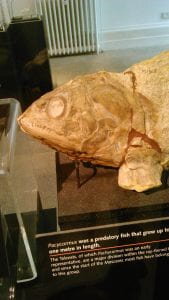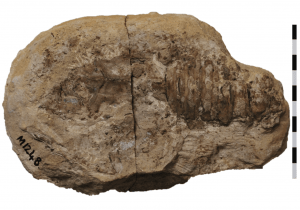Everyone knows about the great extinction at the end of the dinosaur age, but it was far from smooth sailing up until then. The Mesozoic era stretches out 180 million years, during which time many different groups of animals exploded into abundance and then died away. Even without anything so dramatic as an asteroid impact much of these were still significant catastrophes. One such time is the Toarcian Oceanic Anoxic Event (T-OAE).

Breaking down that term; the Toarcian is a section of time within the Jurassic Period, about 183 million years ago (sort of one third into the age of dinosaurs). And an ‘oceanic anoxic event’ refers to there being a sudden shortage of oxygen available in the seas. Even though most do not breathe like us, animals in the oceans are still every bit as dependent on oxygen availability in order to survive. Living through an anoxic event is somewhat equivalent to us being on top of a high mountain where the air is thin, only the fittest specialist will survive and even those that do are hardly thriving.
After likely being kicked off by the volcanic activity of the Karoo-Ferrar in the deep south of the planet (South Africa and Antarctica), a cascade of geological processes caused abnormally high levels of mercury in the seas and a chain reaction leading to anoxia. The changing climate didn’t just affect the oceans, with life on land also feeling the pinch. Even the plant life became less diverse to cope with the volatile world.
One of the best fossil collections displaying this time came from the Strawberry Bank of Ilminster in Somerset. The distinctive limestone containing a multitude of marine life; fish, ichthyosaurs, marine crocodiles, and more. Many of these fossils are preserved incredibly in three dimensions, with nearly every scale and even the gills of some fish clearly visible.

These beautiful fossils were collected in the 1840s by Victorian geologist, Charles Moore, and are now stored in the Bath Royal Literary and Scientific Institute (BRLSI). You may well ask, if the site is so amazing why are there no more recent finds? Well, if you’re willing to go to the location of the site today you’ll find yourself in the middle of a housing estate. And if you want to try and convince the residents to let you dig up their foundations to search for fossils then you absolutely have my blessing to try.
Amongst the glorious fossils were also some less than perfect specimens, representing a major group of marine life; the crustaceans. These poor creatures not only had the misfortunate of living through a brutal time of earth’s history, but, adding insult to injury, they didn’t even get the same stunning preservation in burial as their ecological peers. To make things even worse for the critters, when it was finally time for science to study this hapless bunch, the best they were given was a 21-year-old masters student. Namely, me. Jurassic crustaceans were the subject of my Master’s thesis back in 2015.
But all was not lost, for crustaceans are a very indicative group in a crisis. Anoxia regularly brings high ocean acidity with it, a nightmare for any organism which relies on a large calcium-rich exoskeleton for protection. If you need proof of that you can check some coral reefs today. Acting like time-capsules, their shells hold within them the chemical make-up of the sea in which they were created.
Sadly, this was one analysis I was unable to perform as it can’t be done without destroying the specimen you are testing. This is something the academic world calls ‘Destructive Sampling’, and which the BRLSI calls, ‘Don’t you dare hurt my fossils.’ Not that I would want to do harm to them. I’d grown quite fond of my fossils in the months of study, and had even given them all names. The collection as a whole I called ‘The B52s’, after all, they were my Rock Lobsters.
Though, even a basic analysis was enough to show the community was clearly depauperate (a fancy scientific way of saying it was highly reduced). There is an enormous diversity of crustaceans alive today, but, in the Toarcian, this was not the case. Dominant amongst the fauna was one genus, Eryon.

Aside from this monopoly, the other thing to jump out was their size; every crustacean in the Strawberry Bank was very small. This is an obvious response to an anoxic ocean climate. If you aren’t getting as much oxygen, you aren’t going to grow quickly or large, and if water acidity is making it hard to construct your shell, then you pretty much have no choice but to make less of it. Only one lobster in the collection was significantly bigger than the others; my treasured Coleia at a whopping, mind-boggling 17cm in length (20cm if he stretched… or could stretch).

Without having to go into a detailed analysis here, it is safe to say that the lobsters weren’t doing well in the T-OAE. This is unsurprising given their lifestyle. Anoxia is often most prevalent close to the sea floor, exactly where the lobsters dwelled, as they are benthic organisms.
The benthic lobsters weren’t the only members of ‘The B52s’ though, there were others who spent their time away from the sea floor; planktonic and nektonic (free-swimming) creatures. But talking about those I will save for a future post as although you may have come for the dinosaurs, I know you all stay for the whirlwind tours of niche crustacean ecology. And for those crustaceans who could survive the T-OAE, they were on the verge of a revolution…
Rhys Charles is the Engagement Officer for the Earth Sciences department of the University of Bristol, and has headed the Bristol Dinosaur Project since 2016. (@tweetodontosaur)
Article edited by Fionn Keeley
References
Them II, T. R. et al. (2019) Terrestrial sources as the primary delivery mechanism of mercury to the oceans across the Toarcian Ocean Anoxic Event (Early Jurassic). Earth and Planetary Science Letters. 507: 62 – 72
Slater, S. M. et al. (2019) Substantial vegetation response to Early Jurassic global warming with impacts on oceanic anoxia. Nature Geoscience. 12: 462 – 467

